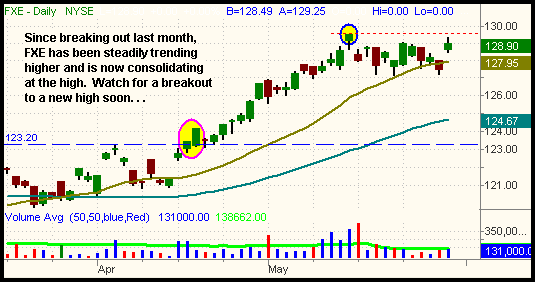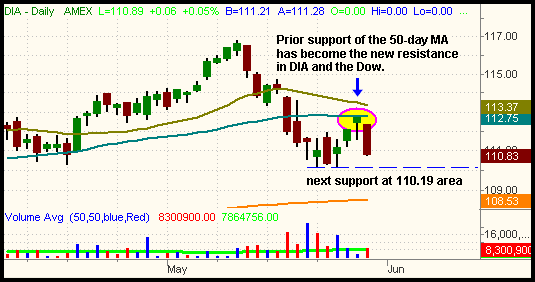Traders returned from the holiday weekend in aggressive selling mode yesterday, causing the major indices to wipe out last week's gains, and then some, in a single day. The Nasdaq plummeted 2.1%, its worst loss since the broad market selloff began on May 11. Small-cap stocks were hit even harder, which resulted in a 2.5% loss for the formerly market-leading Russell 2000 Index. It was the largest percentage loss for the Russell since October 5, 2005. The S&P 500, S&P Midcap 400, and Dow Jones Industrial Average each sustained damage of 1.6% losses. Nearly all the broad market's losses were again the result of a steady intraday downtrend as opposed to a large opening gap down. Since this month's selloff began, there has been a larger than average quantity of "trend" days in the market. This has provided the benefit to traders of enabling stocks and ETFs to realize their volatility through smooth intraday trends as opposed to large opening gaps that are sometimes difficult to profit from.
Total volume in the NYSE rose by 15% yesterday, while volume in the Nasdaq was 12% higher than the previous day's level. The broad-based losses on higher volume resulted in both the S&P and Nasdaq marking another bearish "distribution day." But despite the higher volume selling, volume levels in both exchanges were still below average. Market internals were firmly negative, as confirmed by the fact that every major industry sector we follow closed lower yesterday. In the NYSE, declining volume exceeded advancing volume by a huge margin of more than 8 to 1! The Nasdaq internals were better, but still closed with a negative ratio of approximately 7 to 2. The discrepancy between the NYSE and Nasdaq market internals indicates more selling pressure was beneath the surface of the NYSE than the Nasdaq. Stocks in the NYSE are now playing "catch up" to the large losses in the Nasdaq, which has been showing more relative weakness than both the S&P and Dow until now.
Are you looking for an ETF to buy, perhaps in a cash account that does not permit short selling, but are concerned by the broad weakness that has struck both the U.S. and international markets? If so, we suggest you take a look at a fresh specialty ETF that is completely uncorrelated to stock market prices. The first exchange traded fund that enables you to participate in the foreign exchange currencies markets, the Euro Currency Trust (FXE) trades in direct correlation to the price of the Euro vs. the U.S. dollar. Currently, the dollar is trading at 1.28 to the Euro. FXE closed yesterday at $128.90, which is roughly equal to one hundred times that price. Because the Euro is looking quite bullish right now, FXE is poised to break out higher as well. As you can see on the daily chart below, FXE broke out in the middle of last month, trended higher for for weeks, and has since been consolidating near the high for the past two weeks. The 20-day moving average is also acting as support:

Based on its bullish consolidation, FXE can be bought over its May 12 high of 129.46. Aggressive traders might consider buying a partial position just over yesterday's high. A logical place for a protective stop loss is below the recent consolidation, around the $127 area. Specific trigger, stop, and target prices are provided to subscribers below. In addition to this currency ETF, don't forget about the other specialty ETFs such as those that track the prices of commodities and government bonds.
As for the major indices, one thing we like is how the Dow Jones Industrial Average reversed perfectly after running into resistance of its 50-day moving average yesterday. Take a look at the daily chart of the Dow Jones DIAMONDS (DIA), which we are currently short:

Last week's low of 110.19 is the next support level in DIA (11,030 in the Dow itself). If DIA breaks that low, it should quickly slide down to its 200-day moving average at the 108.50 area.
The S&P 500, which we analyzed in yesterday's newsletter, also reversed nicely after running into resistance of its 38.2% Fibonacci retracement level. The index closed yesterday right above its 200-day moving average that it bounced off of last week. Obviously, that 200-MA is a pivotal support level, so we'll be watching to see whether the S&P again attempts to find support here or if it quickly falls to new lows.
Deron Wagner is the Founder and Head Trader of both Morpheus Capital LP, a U.S. hedge fund, and Morpheus Trading Group, a trader education firm launched in 2001 that provides daily technical analysis of the leading ETFs and stocks. For a free trial to the full version of The Wagner Daily or to learn about Wagner's other services, visit MorpheusTrading.com or send an e-mail to deron@morpheustrading.com.